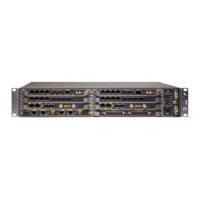Product information and planning
MPR-e 163
TMN communication channels
On 9500 MPR Network Element three types of TMN communication channels are present:
• 2 NMS interfaces through the use of VLANs 4085 and 4086 and 2 dedicated RJ45
ports.
• In-band TMN through the use of any USER port requiring the activation of a user
defined VLAN
• TMN-RF allowing the management of a remote NE through radio.
TMN-RF
The TMN-RF interface is associated with the radio port and is used to connect the MPR-e to
the NE on the other side of the radio link. There are two different selectable modes for this
interface: PPP or In-Band.
When an MPR-e is interfacing with any NE belonging to the MPR family at the other end of
a radio link, TMN-RF PPP is required. TMN-RF PPP doesn’t have an explicit IP address
configuration because it automatically inherits the NE IP address.
When the NE at the other end is a 7705 SAR in Single NE with MPR-e, TMN-RF In-Band is
required. As TMN In-Band, this interface requires a unique IP address, a subnet mask and a
unique VLAN ID (it cannot be the same as the TMN In-Band VLAN ID). The 7705 SAR
must have a similar valid interface within the same subnet with the same VLAN ID as the
MPR-e to establish IP connectivity over the radio link.
TMN In-Band
The TMN In-Band interface dedicated to TMN is used to connect the MPR-e NE to the LAN
exchanging TMN information through a VLAN mixed with the user Ethernet traffic.
This interface has a local default IP address, and the operator can reconfigure this IP address
as a public address.
The IP address of the TMN In-Band interface can be equal to the local IP address (NE IP
address).
If the IP address is different from the NE IP address, the TMN In-Band subnet is different
from the NE logical subnet calculated by masking the NE IP address with the TMN In-Band
subnet mask.

